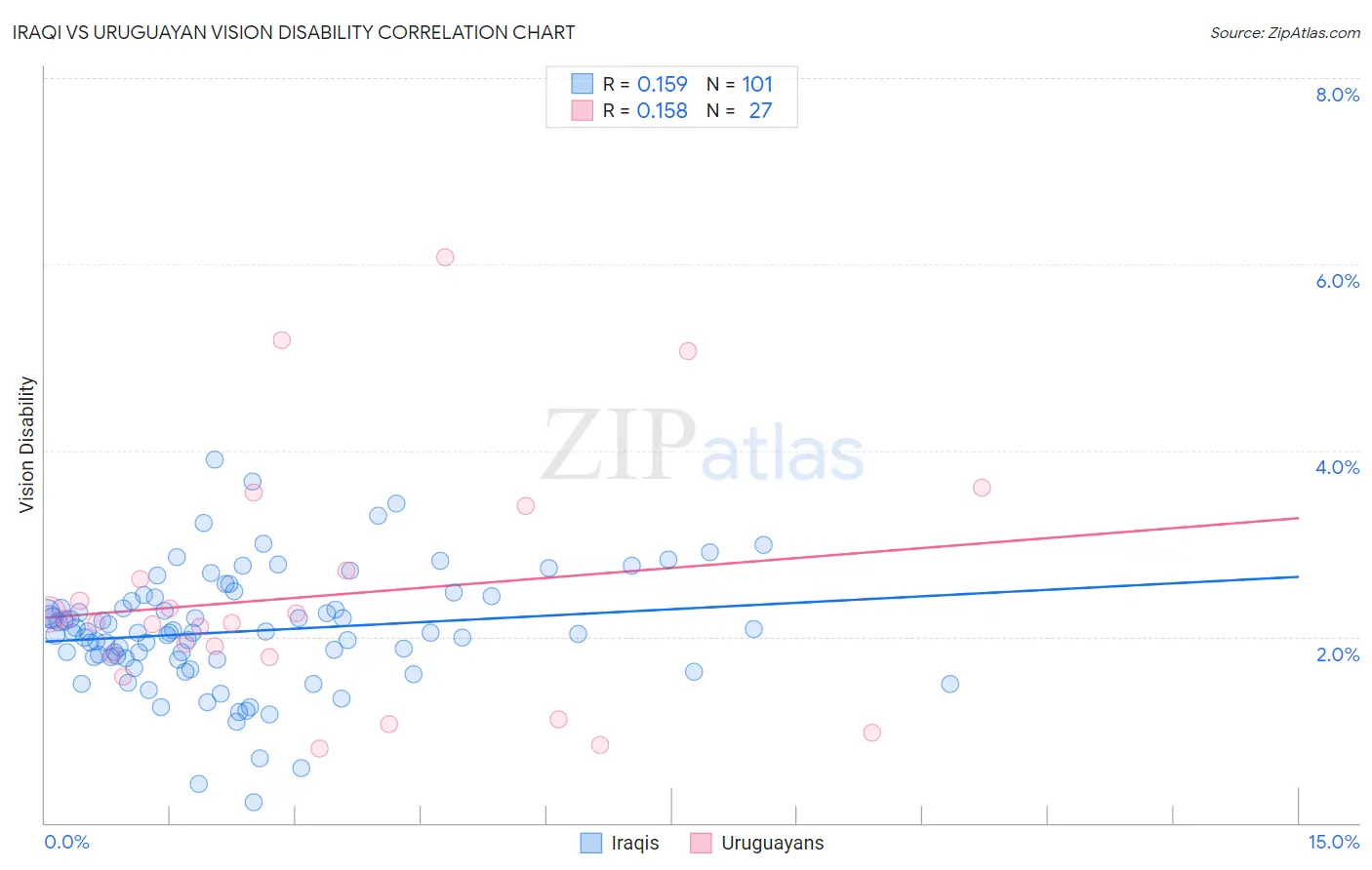Iraqi vs Uruguayan Vision Disability
COMPARE
Iraqi
Uruguayan
Vision Disability
Vision Disability Comparison
Iraqis
Uruguayans
2.1%
VISION DISABILITY
67.7/ 100
METRIC RATING
161st/ 347
METRIC RANK
2.2%
VISION DISABILITY
42.7/ 100
METRIC RATING
180th/ 347
METRIC RANK
Iraqi vs Uruguayan Vision Disability Correlation Chart
The statistical analysis conducted on geographies consisting of 170,621,066 people shows a poor positive correlation between the proportion of Iraqis and percentage of population with vision disability in the United States with a correlation coefficient (R) of 0.159 and weighted average of 2.1%. Similarly, the statistical analysis conducted on geographies consisting of 144,772,408 people shows a poor positive correlation between the proportion of Uruguayans and percentage of population with vision disability in the United States with a correlation coefficient (R) of 0.158 and weighted average of 2.2%, a difference of 1.7%.

Vision Disability Correlation Summary
| Measurement | Iraqi | Uruguayan |
| Minimum | 0.23% | 0.80% |
| Maximum | 3.9% | 6.1% |
| Range | 3.7% | 5.3% |
| Mean | 2.1% | 2.4% |
| Median | 2.0% | 2.1% |
| Interquartile 25% (IQ1) | 1.8% | 1.8% |
| Interquartile 75% (IQ3) | 2.4% | 2.7% |
| Interquartile Range (IQR) | 0.64% | 0.93% |
| Standard Deviation (Sample) | 0.63% | 1.3% |
| Standard Deviation (Population) | 0.63% | 1.3% |
Demographics Similar to Iraqis and Uruguayans by Vision Disability
In terms of vision disability, the demographic groups most similar to Iraqis are Hungarian (2.1%, a difference of 0.030%), Austrian (2.1%, a difference of 0.090%), Icelander (2.1%, a difference of 0.12%), Immigrants from Bangladesh (2.1%, a difference of 0.16%), and Immigrants from Iraq (2.1%, a difference of 0.21%). Similarly, the demographic groups most similar to Uruguayans are Immigrants from North America (2.2%, a difference of 0.12%), Immigrants from Oceania (2.2%, a difference of 0.16%), Slavic (2.2%, a difference of 0.21%), Yugoslavian (2.2%, a difference of 0.25%), and Immigrants from Fiji (2.2%, a difference of 0.32%).
| Demographics | Rating | Rank | Vision Disability |
| Austrians | 69.0 /100 | #160 | Good 2.1% |
| Iraqis | 67.7 /100 | #161 | Good 2.1% |
| Hungarians | 67.4 /100 | #162 | Good 2.1% |
| Icelanders | 66.1 /100 | #163 | Good 2.1% |
| Immigrants | Bangladesh | 65.5 /100 | #164 | Good 2.1% |
| Immigrants | Iraq | 64.8 /100 | #165 | Good 2.1% |
| Immigrants | England | 62.8 /100 | #166 | Good 2.1% |
| Immigrants | Africa | 62.6 /100 | #167 | Good 2.1% |
| Brazilians | 62.2 /100 | #168 | Good 2.1% |
| South American Indians | 57.4 /100 | #169 | Average 2.2% |
| Swiss | 55.7 /100 | #170 | Average 2.2% |
| Lebanese | 54.3 /100 | #171 | Average 2.2% |
| Northern Europeans | 50.1 /100 | #172 | Average 2.2% |
| Scandinavians | 50.0 /100 | #173 | Average 2.2% |
| Immigrants | Canada | 50.0 /100 | #174 | Average 2.2% |
| Immigrants | Fiji | 47.6 /100 | #175 | Average 2.2% |
| Yugoslavians | 46.5 /100 | #176 | Average 2.2% |
| Slavs | 46.0 /100 | #177 | Average 2.2% |
| Immigrants | Oceania | 45.1 /100 | #178 | Average 2.2% |
| Immigrants | North America | 44.5 /100 | #179 | Average 2.2% |
| Uruguayans | 42.7 /100 | #180 | Average 2.2% |